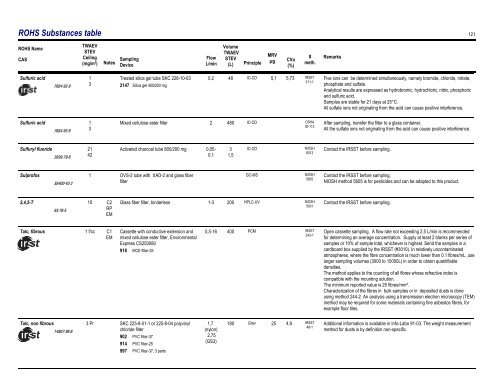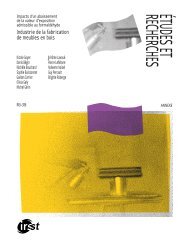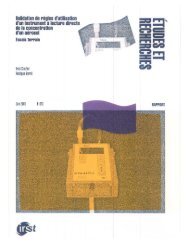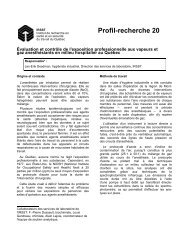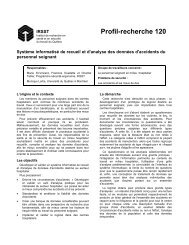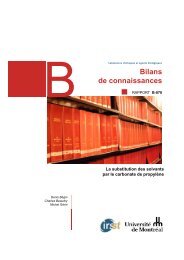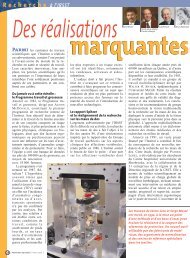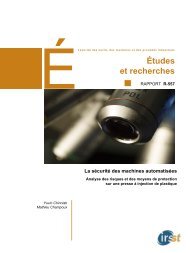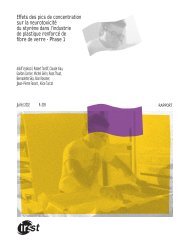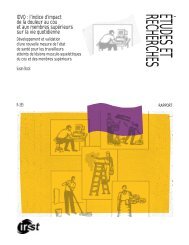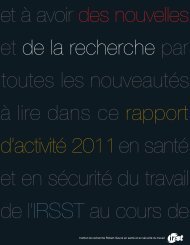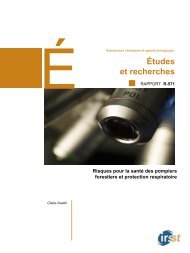Sampling Guide for Air Contaminants in the Workplace - Irsst
Sampling Guide for Air Contaminants in the Workplace - Irsst
Sampling Guide for Air Contaminants in the Workplace - Irsst
Create successful ePaper yourself
Turn your PDF publications into a flip-book with our unique Google optimized e-Paper software.
ROHS Substances table<br />
121<br />
ROHS Name<br />
CAS<br />
TWAEV<br />
STEV<br />
Ceil<strong>in</strong>g<br />
(mg/m³)<br />
Notes<br />
<strong>Sampl<strong>in</strong>g</strong><br />
Device<br />
Flow<br />
L/m<strong>in</strong><br />
Volume<br />
TWAEV<br />
STEV<br />
(L)<br />
Pr<strong>in</strong>ciple<br />
MRV<br />
µg<br />
CVa<br />
(%)<br />
#<br />
meth.<br />
Remarks<br />
Sulfuric acid<br />
7664-93-9<br />
1<br />
3<br />
Treated silica gel tube SKC 226-10-03<br />
2147 Silica gel 400/200 mg<br />
0,2 IC-CD 5,1 5,73<br />
48 IRSST<br />
211-1<br />
Five ions can be determ<strong>in</strong>ed simultaneously, namely bromide, chloride, nitrate,<br />
phosphate and sulfate.<br />
Analytical results are expressed as hydrobromic, hydrochloric, nitric, phosphoric<br />
and sulfuric acid.<br />
Samples are stable <strong>for</strong> 21 days at 25°C.<br />
All sulfate ions not orig<strong>in</strong>at<strong>in</strong>g from <strong>the</strong> acid can cause positive <strong>in</strong>terference.<br />
Sulfuric acid<br />
7664-93-9<br />
1<br />
3<br />
Mixed cellulose ester filter<br />
2 480 IC-CD<br />
OSHA<br />
ID-113<br />
After sampl<strong>in</strong>g, transfer <strong>the</strong> filter to a glass conta<strong>in</strong>er.<br />
All <strong>the</strong> sulfate ions not orig<strong>in</strong>at<strong>in</strong>g from <strong>the</strong> acid can cause positive <strong>in</strong>terference.<br />
Sulfuryl fluoride<br />
2699-79-8<br />
21<br />
42<br />
Activated charcoal tube 800/200 mg<br />
0,05-<br />
0,1<br />
3<br />
1,5<br />
IC-CD<br />
NIOSH<br />
6012<br />
Contact <strong>the</strong> IRSST be<strong>for</strong>e sampl<strong>in</strong>g.<br />
Sulprofos<br />
35400-43-2<br />
1 OVS-2 tube with XAD-2 and glass fiber<br />
GC-MS<br />
NIOSH<br />
5605<br />
filter<br />
Contact <strong>the</strong> IRSST be<strong>for</strong>e sampl<strong>in</strong>g.<br />
NIOSH method 5605 is <strong>for</strong> pesticides and can be adapted to this product.<br />
2,4,5-T<br />
93-76-5<br />
10 C2<br />
RP<br />
EM<br />
Glass fiber filter, b<strong>in</strong>derless<br />
1-3 200 HPLC-UV<br />
NIOSH<br />
5001<br />
Contact <strong>the</strong> IRSST be<strong>for</strong>e sampl<strong>in</strong>g.<br />
Talc, fibrous<br />
1 f/cc C1<br />
EM<br />
Cassette with conductive extension and<br />
mixed cellulose ester filter, Environmental<br />
Express CS250080<br />
918 MCE filter-25<br />
0,5-16 PCM<br />
400 IRSST<br />
243-1<br />
Open cassette sampl<strong>in</strong>g. A flow rate not exceed<strong>in</strong>g 2.5 L/m<strong>in</strong> is recommended<br />
<strong>for</strong> determ<strong>in</strong><strong>in</strong>g an average concentration. Supply at least 2 blanks per series of<br />
samples or 10% of sample total, whichever is highest. Send <strong>the</strong> samples <strong>in</strong> a<br />
cardboard box supplied by <strong>the</strong> IRSST (#3010). In relatively uncontam<strong>in</strong>ated<br />
atmospheres, where <strong>the</strong> fibre concentration is much lower than 0.1 fibres/mL, use<br />
larger sampl<strong>in</strong>g volumes (3000 to 10000L) <strong>in</strong> order to obta<strong>in</strong> quantifiable<br />
densities.<br />
The method applies to <strong>the</strong> count<strong>in</strong>g of all fibres whose refractive <strong>in</strong>dex is<br />
compatible with <strong>the</strong> mount<strong>in</strong>g solution.<br />
The m<strong>in</strong>imum reported value is 25 fibres/mm².<br />
Characterization of <strong>the</strong> fibres <strong>in</strong> bulk samples or <strong>in</strong> deposited dusts is done<br />
us<strong>in</strong>g method 244-2. An analysis us<strong>in</strong>g a transmission electron microscopy (TEM)<br />
method may be required <strong>for</strong> some materials conta<strong>in</strong><strong>in</strong>g f<strong>in</strong>e asbestos fibres, <strong>for</strong><br />
example floor tiles.<br />
Talc, non fibrous<br />
14807-96-6<br />
3 Pr SKC 225-8-01-1 or 225-8-04 polyv<strong>in</strong>yl 1,7 180 Grav 25 4,9 IRSST<br />
48-1<br />
chloride filter<br />
(nylon)<br />
902<br />
914<br />
PVC filter-37<br />
PVC filter-25<br />
2,75<br />
(GS3)<br />
997 PVC filter-37, 3 parts<br />
Additional <strong>in</strong><strong>for</strong>mation is available <strong>in</strong> Info-Labo 91-03. The weight measurement<br />
method <strong>for</strong> dusts is by def<strong>in</strong>ition non-specific.


